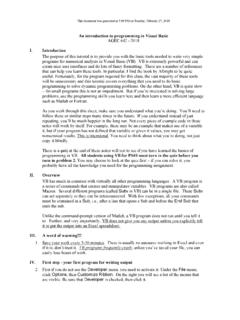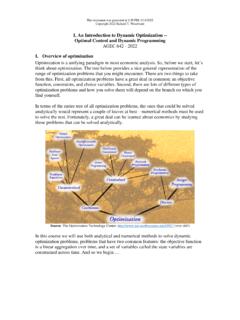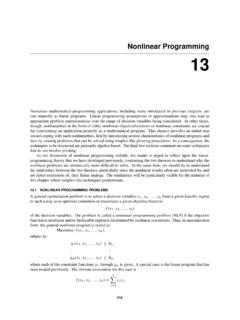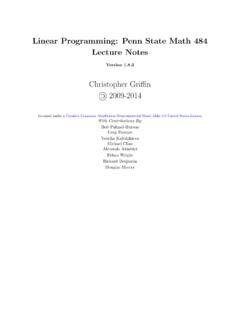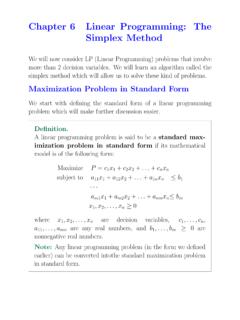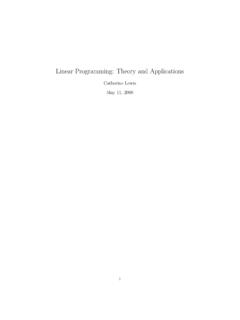Transcription of CHAPTER IV: DUALITY IN LINEAR PROGRAMMING
1 McCarl and Spreen, 2020 DUALITY IN LINEAR PROGRAMMING 1 CHAPTER IV: DUALITY IN LINEAR PROGRAMMING Basic DUALITY .. 1 Primal-Dual Solution Inter-Relationships .. 3 Objective Function Interrelationships .. 3 Constructing Dual Solutions .. 4 Complementary Slackness .. 5 Zero Profits .. 6 Finding the Dual Solution Information .. 6 DUALITY Under Other Model Forms .. 6 The Character of Dual Solutions .. 9 Degeneracy and Shadow Prices .. 10 Primal Columns are Dual Constraints .. 11 References .. 11 Economic theory indicates that scarce (limited) resources have value. For example, prime agricultural land is limited and has value (a rental price). On the other hand, air is effectively unlimited and therefore does not have a market value. In LP models, limited resources are allocated, so they should be, valued. Whenever we solve an LP problem, we implicitly solve two problems: the primal resource allocation problem, and the dual resource valuation problem.
2 This CHAPTER covers the resource valuation, or as it is commonly called, the Dual LP problem and its relationship to the original, primal, problem. Basic DUALITY The study of DUALITY is very important in LP. Knowledge of DUALITY allows one to develop increased insight into LP solution interpretation. Also, when solving the dual of any problem, one simultaneously solves the primal. Thus, DUALITY is an alternative way of solving LP problems. However, given today's computer capabilities, this is an infrequently used aspect of DUALITY . Therefore, we concentrate on the study of DUALITY as a means of gaining insight into the LP solution. We will also discuss the ways that primal decision variables place constraints upon the resource valuation information. The Primal problem can be written as: tsMax Associated with this primal problem is a dual resource valuation problem. The dual of the above McCarl and Spreen, 2020 DUALITY IN LINEAR PROGRAMMING 2 problem is i allfor 0 Uj allfor where Ui are the dual variables.
3 If the primal problem has n variables and m resource constraints, the dual problem will have m variables and n constraints. There is a one-to-one correspondence between the primal constraints and the dual variables; , U1 is associated with the first primal constraint, U2 with the second primal constraint, etc. As we demonstrate later, dual variables (Ui) can be interpreted as the marginal value of each constraint's resources. These dual variables are usually called shadow prices and indicate the imputed value of each resource. A one-to-one correspondence also exists between the primal variables and the dual constraints; X1 is associated with the first dual constraint (c a 11iii U), X2 is associated with the second dual constraint (c a 22iii U), etc. An example aids in explaining the dual. Consider the primal model: The associated dual problem is )(,)(120019)(170020)( )(Re28012min)()()(2121212121tynonegativi UUXUUXUUXUUtsPaymentssourceUUprofitslabo rcapvannewfinefancy The dual problem economic interpretation is important.
4 The variable U1 gives the marginal value of the first resource, or van capacity. Variable U2 gives the marginal value of the second resource, or labor in this case. The first dual constraint restricts the value of the resources used in producing a unit of Xfancy to be greater than or equal to the marginal revenue contribution of Xfancy. In the primal problem Xfancy uses one unit of van capacity and 25 units of labor, returning $2000, while the dual problem requires van capacity use times its marginal value (1U1) plus labor use times its marginal value (25U2) to be greater than or equal to the profit earned when one unit of Xfancy is produced (2000). Similarly, constraint 2 requires the marginal value of van capacity plus 20 times the marginal value of labor to be greater than or equal to 1700, which is the amount of profit earned by producing Xfine and the third constraint does the same for Xnew. Thus, the dual variable values are constrained such that the marginal value of the resources used by each primal variable is no less than the marginal profit contribution of that variable.
5 Now suppose we examine the objective function. This function minimizes the total marginal value of the resources on hand. In the example, this amounts to the van capacity endowment times the marginal value of van capacity (12U1) plus the labor endowment times the marginal value of labor (320U2). Thus, the dual variables arise from a problem minimizing the marginal value of the resource endowment subject to constraints requiring that the marginal value of the resources used in producing each product must be at least as great as the marginal value of the product. This can be viewed as the problem of a resource purchaser in a perfectly competitive market. Under such circumstances, the purchaser would have to pay at least as much for the resources as the value of the goods produced using those resources. However, the purchaser would try to minimize the total cost of the resources acquired. The resultant dual variable values are measures of the marginal value of the resources.
6 The objective function is the minimum value of the resource endowment. Any slack in the constraints is the amount that cost exceeds revenue. Primal-Dual Solution Inter-Relationships Several relationships exist between primal and dual solutions which are fundamental to understanding DUALITY and interpreting LP solutions. UXCAUtsbAXtsbUMinCXMaxDualimal First, let us introduce some notation. The primal dual pair of LP problems in matrix form is. Now let us examine how the problems are related. Objective Function Interrelationships Suppose we have any two feasible primal and dual solutions X*, U* and we want to determine the relationship between the objective functions CX*and U* b. We know the feasible solutions must satisfy 0 U 0X CAU and bAX** To determine the relationship, we take the above constraint inequalities (not the non-negativity conditions) and pre-multiply the left one by U* while post-multiplying the right one by X*.
7 BUAXUCXAXU** Noting that the term U* AX* is common to both inequalities we get b*'U*AX*'U*CX b*'U*CX This shows that the dual objective function value is always greater than or equal to the primal objective function value for any pair of feasible solutions. Constructing Dual Solutions We can construct an optimal dual solution from an optimal primal solution. Suppose an optimal primal solution is given by XB* = B-1b and XNB* = 0. This solution must be feasible; , XB* = B-1b > 0. It also must have XNB > 0 and must satisfy nonnegative reduced cost for the nonbasic variables CBB-1 ANB - CNB > 0. Given this, suppose we try U* = CBB-1 as a potential dual solution. First, let us investigate whether this is a feasible solution in the dual constraints. To be feasible, we must have U* A > C and U* > 0. If we set U* = CBB-1, then we know U* ANB - CNB > 0 because at optimality this is exactly equivalent to the reduced cost criteria, , CBB-1 ANB - CNB > 0.
8 Further, we know for the basic variables the reduced cost is CBB-1AB - CB = CBB-1B - CB = CB - CB = 0, so U* B = CB. By unifying these two statements, we know when U* = CBB-1 then the dual inequalitiesU* A > C are satisfied. Now we need to know if the dual nonnegativity conditions U > 0 are satisfied. We can look at this by looking at the slacks in the problem. For the slacks, A contains an identity matrix and the associated entries in C are all 0's. Thus, for the part of the UA > C that covers the slacks and since we know that C AUSS* where C and ASS are the portions of A and C relevant to the slacks. Substituting in the known structure of AS and CS, , AS = I and CS = 0 yields U* > 0 or U > 0. So the U's are non-negative. Thus, BC = U1B* is a feasible dual solution. Now the question becomes, is this choice optimal? In this case the primal objective function Z equals CX* = CBXB* + CNBXNB* and since XNB* equals zero, then Z = CBB-1b + CNB0 = CBB-1b.
9 Simultaneously, the dual objective equals U* b = CBB-1b which equals the primal objective. Therefore, the primal and dual objectives are equal at optimality. Furthermore, since the primal objective must be less than or equal to the dual objective for any feasible pair of solutions and since they are equal, then clearly CX* cannot get any larger nor can U* b get any smaller, so they must both be optimal. Therefore, CBB-1 is an optimal dual solution. This demonstration shows that given the solution from the primal the dual solution can simply be computed without need to solve the dual problem. In addition given the derivation in the last CHAPTER we can establish the interpretation of the dual variables. In particular, since the optimal dual variables equal CB B-1 (which are called the primal shadow prices) then the dual variables are interpretable as the marginal value product of the resources since we showed .U = B C = b Z*1B Complementary Slackness Yet another, interrelationship between the primal and dual solutions is the so called complementary slackness relation.
10 This states that given optimal values U* and X* then ) A U(0=)AX (b U** This result coupled with the primal and dual feasibility restrictions (U > 0; UA > C; AX < b; X > 0) implies that (in the absence of degeneracy and multiple optimal solutions) for each constraint, either the resource is fully used (bi - (AX)i = 0) with the associated dual variable (Ui*) nonzero, or the dual variable is zero with associated unused resources (bi - (AXj)) being nonzero. Alternatively, for each variable (again ignoring degeneracy) at optimality, either the variable level (Xj) is non-zero with zero reduced cost (U* A)j - cj = 0) or the variable is set to zero with a non-zero reduced cost. This result may be proven using matrix algebra. Given optimal primal (X*) and dual (U*) solutions .XC) A U(= )AX (b U=Let** Now suppose we add together + and examine the result. Name + , equals U* (b - AX*) + (U* A - C)X* which equals U* b - U* AX* + U* AX* - CX* = U* b - CX*.
